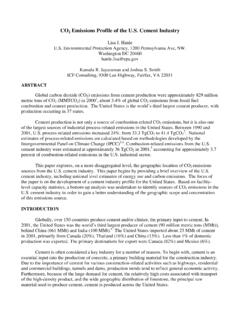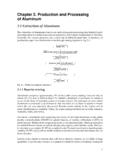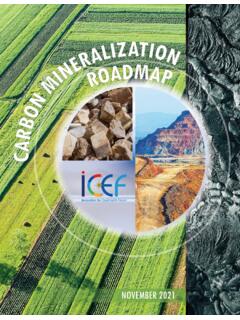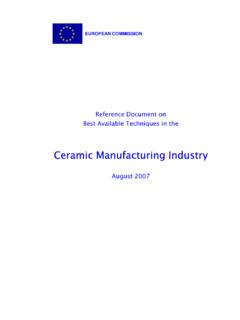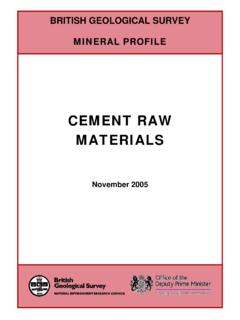Transcription of IMPACT OF PLASTICS ON ENVIRONMENTAL POLLUTION
1 National Seminar on IMPACT of Toxic Metals, Minerals and Solvents leading to ENVIRONMENTAL POLLUTION -2014 Journal of Chemical and Pharmaceutical Sciences ISSN: 0974-2115 JCHPS Special Issue 3: October 2014 Page 87 IMPACT OF PLASTICS ON ENVIRONMENTAL POLLUTION * , Rajeswari, 1 Department of Freshmen Engineering, PVPSIT, Kanuru, Vijayawada, AP. 2 Department of chemistry, Govt. College for Women (Autonomous), Guntur *Corresponding author: Email: ABSTRACT Thousands of plastic factories are producing tons of plastic goods which are popularly used by the people because of their ease, cheapness and convenience. Due to non-biodegradable nature they cause hazardous negative IMPACT on the environment.
2 Disposal of plastic waste which are major cause of environment POLLUTION becomes carcinogenic to human, birth defects, impaired immunity,endocrine disruption, development and reproductive effect. In addition to dumping of plastic material into marine, a large number of species are known to be harmed or killed which could jeopardize their survival, especially since many are already endangered by other forms of anthropogenic activities. Marine animals are mostly affected through entanglement in and ingestion of plastic litter. Less conspicuous forms,such as plastic pellets and scrubber are also hazardous. Creating public awareness on the importance of healthy environment, mechanism of controlling the generation of wastes at the source, alternative disposal ways, establishing additional drop-off-areas (land fills) and incineration mechanisms, plastic recycling facilities are also recommended.
3 Keywords: Plastic goods, hazardous plastic waste , anthropogenic activities. Plastic are high molecular weight organic polymers which can be moulded into desired shapes by the application of heat and pressure . 1. INTRODUCTION The word plastic is derived from the greek (plastikos) meaning capable of being shaped or molded. Plastic that are made up of polymers having only aliphatic (linear) C atoms in their backbone chains. : poly propylene. PLASTICS that are made up of heterochain polymers contain O, N, S in their backbone chains, in addition to C. : poly carbonate. Plastic behaviour of polymers is influenced by their morphology (arrangement of molecules).they are either amorphous or crystalline. Most thermosets are amorphous, while thermoplastics may be amorphous or semi crystalline. PLASTICS are a range of synthetic or semi-synthetic polymerization products that can be molded into a permanent object having the property of plasticity.
4 Plastic are found extensive industrial applications. PLASTICS having a variety of properties are available at present. They have low specific gravities, ease of fabrication, resistance to low thermal and electrical conductivities. Many PLASTICS can take range of colour to enable them useful for decorative purposes. PLASTICS are widely used in making electical instruments, telephones, panelling for walls,instrument boards, automoblile parts, lamps, googles, optical instruments, household appliances, etc. Plastic materials dumped into the earth prevent the production of nutrients in the soil. Because of this, the fertility of the soil is reduced and affects the agriculture sector. When its persistence in the environment can do great harm. It causes immune and enzyme disorders, hormonal disruption leading to endocrinal disorders and even infertility and is also considered as carcinogenic (cancer).
5 Not only human health, it dangerously effects other animal life and alters the environment (air,water and soil) sustainability causing hazardous POLLUTION . 2. CLASSIFICATION PLASTICS can devided into two general categories and they are and 2. Thermosetting PLASTICS Thermoplastics: Thermoplastics have either linear or branched structure and can be amorphous or semicrystalline materials. Polymeric chains are held together by weak vander waal's forces or dipole-dipole forces or hydrogen bonding and hence do not have cross-links. Thermoplastic soften on heating and harden on cooling because of weak vander waal's forces. These PLASTICS can remoulded, reshaped and reused. Thermoplastics can be reclaimed from waste .examples for thermoplastic are cellulose derivatives, polyamides, polystyrene, polyvinyls, polyethylenes,etc. Thermosetting PLASTICS : Thermosetting PLASTICS have three-dimensional, cross-linked, networked structures in which the polymeric chains are held together by cross-links(strong covalent bonds).
6 These PLASTICS donot soften on heating and they are hard, strong and more brittle. Thermosetting PLASTICS cannot be remoulded and hence cannot be for thermosetting plastic are phenolic resins(bakelite), polyesters(terylene), etc. 3. Disposal of Plastic When PLASTICS are used, recycled, or disposed of, or left in the environment as litter, they break down and release harmful chemicals. These pollutants include heavy metals such as cadmium and lead, and chemicals such as benzene, dioxins, and other pollutants, which all release harmful toxins into our air, water, and bodies. Right now, most plastic is being wasted sent to landfills or, more likely, incinerators. Burning plastic in incinerators releases toxic heavy metals and chemicals. Incinerators produce a variety of toxic discharges to the air, water, and ground that are significant sources of powerful pollutants, including dioxin and other chlorinated organic compounds that are well known for their toxic effects on human health and the environment.
7 Many of these toxins enter the food supply and become more concentrated as they move up through the food chain. In addition to air and water emissions, incinerators create toxic ash or slag which contains heavy metals, dioxins, and other pollutants. This toxic ash must be land filled, and the pollutants present in the ash can then leach into groundwater. National Seminar on IMPACT of Toxic Metals, Minerals and Solvents leading to ENVIRONMENTAL POLLUTION -2014 Journal of Chemical and Pharmaceutical Sciences ISSN: 0974-2115 JCHPS Special Issue 3: October 2014 Page 88 In fact, garbage incinerators and medical waste incinerators are two of the largest sources of dioxin identified by the ENVIRONMENTAL Protection Agency.
8 Dioxin is the common name for a class of 75 chemicals. It is a toxic waste product formed when waste containing chlorine is burned or when products containing chlorine are manufactured. Dioxins are among the most potent synthetic chemicals ever tested, causing cancer and harming our immune and reproductive systems even at very low concentrations. In landfills, leachate is produced when water picks up toxins as it seeps through the trash. This trash includes PLASTICS of all types, even older PLASTICS that have been proven to be toxic but are still in our landfills. Although landfills attempt to collect this toxic leachate, it also leaks into ground and surface water, releasing pollutants into the environment and causing health risks for humans and wildlife. 4. REGULATION OF PLASTIC INDUSTRY IN INDIA The growth of plastic small scale processing and reprocessing industries, as other Small Scale Industries (SSI) in India, began in the decade of eighties with the announcement of the new industrial policy.
9 Plastic processing and reprocessing industries are also exempted from monitoring by POLLUTION Control Board. With regard to safety guidelines for toys in India, Bureau of Indian Standards (BIS) has published three standards which deals with safety aspects of toys related to mechanical and physical properties, flammability requirements and migration of certain elements (limiting heavy metals in toys). None of these standards give limits for phthalates in children's toys and child care articles. The BIS guideline with regard to toy production is self-regulatory and not mandatory. Toy manufacturers do not register even for the ISI mark for their products and therefore do not follow even the voluntary standards. Regulation of PLASTICS waste, particularly manufacture and use of recycled PLASTICS carry bags and containers is being regulated in the country as per Recycled PLASTICS Manufacture and Usage Rules , 1999 and as amended in 2003.
10 This has now been replaced by Plastic Waste (Management and Handling) Rules, 2011. Some of the salient features of the new Rules are: ban on use of plastic materials in sachets for storing, packing or selling gutkha, tobacco and pan masala, no food stuffs will be allowed to be packet in recycled PLASTICS or compostable PLASTICS , recycled carry bags to have specific BIS standards, colour to the prescription by the Bureau of Indian Standards (BIS), Uniform thickness shall not be less than 40 microns in carry bags etc. One of the major provisions under the new Rules is the explicit recognition of the rule of waste pickers. The new Rules require the municipal authority to constructively engage agencies or groups working in waste management including these waste pickers. This is the very first time that such a special dispensation has been made.


